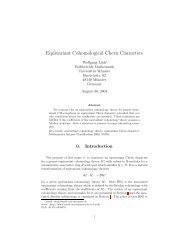Connes-Chern Character for Manifolds with Boundary and ETA ...
Connes-Chern Character for Manifolds with Boundary and ETA ...
Connes-Chern Character for Manifolds with Boundary and ETA ...
You also want an ePaper? Increase the reach of your titles
YUMPU automatically turns print PDFs into web optimized ePapers that Google loves.
CONNES-CHERN CHARACTER AND <strong>ETA</strong> COCHAINS 79<br />
Proof. For t → 0+ the estimate follows from Proposition B.5.1.<br />
For t → ∞ <strong>and</strong> p = 1 the estimate follows from Proposition B.1 <strong>and</strong> (B.12) by<br />
taking the contour as in Figure 6. For p = ∞ the estimate is a simple consequence<br />
of the Spectral Theorem. The general case then follows again from the interpolation<br />
inequality (B.15).<br />
□<br />
Finally we state the analogue of Proposition B.4 <strong>for</strong> the heat kernel.<br />
Proposition B.7. Let A ∈ Diff a (M, W ) be a differential operator such that [D 2 , A] has<br />
compact support (in the sense of Definition B.3) <strong>and</strong> is of order ≤ a + 1.<br />
Then <strong>for</strong> t > 0 the operator [A, e −tD2 ] is of trace class. For t 0 , ε > 0 there is a<br />
constant C(t 0 , ε) such that <strong>for</strong> all 1 ≤ p ≤ ∞ we have the following estimate in the<br />
Schatten p–norm<br />
‖[A, e −tD2 dim M−1+ε<br />
−a/2−<br />
]‖ p ≤ C(t 0 , ε) t<br />
2p<br />
, 0 < t ≤ t 0 ; (B.17)<br />
C(t 0 , ε) is independent of p.<br />
If D is a Fredholm operator then <strong>for</strong> any 0 < δ < inf spec ess D 2 <strong>and</strong> any ε > 0 there<br />
is a constant C(δ, ε) such that <strong>for</strong> 1 ≤ p ≤ ∞<br />
‖[A, e −tD2 dim M−1+ε<br />
−a/2−<br />
(I − H)]‖ p ≤ C(δ, ε) t<br />
2p<br />
e −tδ , 0 < t < ∞. (B.18)<br />
Proof. For p = 1 this follows from Proposition B.4 <strong>and</strong> the contour integral representation<br />
(B.12) by taking the contours as in Figure 5 <strong>for</strong> t → 0+ <strong>and</strong> as in Figure 6 in<br />
the Fredholm case as t → ∞. For p = ∞ the estimates are a simple consequence of<br />
the Spectral Theorem. The general case then follows from the interpolation inequality<br />
(B.15).<br />
□<br />
B.3. Estimates <strong>for</strong> the JLO integr<strong>and</strong>. Recall that we denote the st<strong>and</strong>ard k–<br />
simplex by ∆ k := { (σ 0 , ..., σ k ) ∈ R k+1 ∣ ∣ σ j ≥ 0, σ 0 + ... + σ k = 1 } . Furthermore, recall<br />
the notation (2.3).<br />
Proposition B.8. Let A j ∈ Diff a j<br />
(M; W ), j = 0, ..., k, be D a j<br />
–bounded differential<br />
∑<br />
operators on M, a := k a j . Furthermore, assume that supp A j0 is compact <strong>for</strong> at least<br />
j=0<br />
one index j 0 .<br />
1. For t 0 , ε > 0 there is a constant C(t 0 , ε) such that <strong>for</strong> all σ = (σ 0 , ..., σ k ) ∈<br />
∆ k , σ j > 0,<br />
‖A 0 e −σ 0tD 2 A 1 · . . . · A k e −σ ktD 2 ‖ 1<br />
( k∏<br />
)<br />
≤ C(t 0 , ε) σ −a j/2<br />
j t −a/2−(dim M)/2−ε , 0 < t ≤ t 0 .<br />
j=0<br />
(B.19)<br />
In particular, if a j ≤ 1, j = 0, ..., k, then<br />
‖(A 0 , ..., A k ) √ tD ‖ = O(t−a/2−(dim M)/2−0 ), t → 0 + . (B.20)<br />
2. Assume additionally that D is Fredholm <strong>and</strong> denote by H the orthogonal projection<br />
onto Ker D. Then <strong>for</strong> ε > 0 <strong>and</strong> any 0 < δ < inf spec ess D 2 there is a constant C(δ, ε)

















